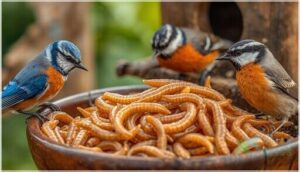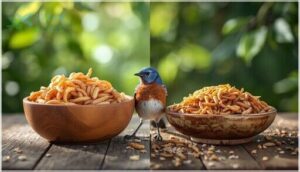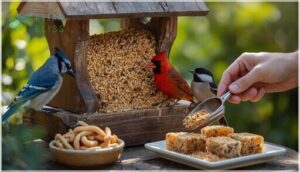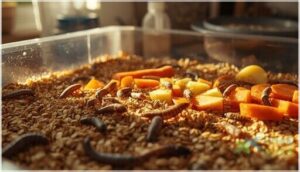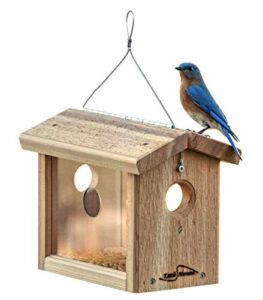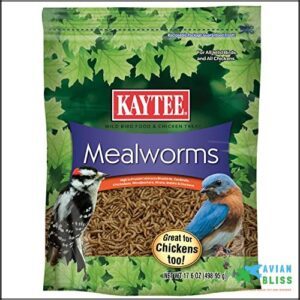This site is supported by our readers. We may earn a commission, at no cost to you, if you purchase through links.

You fill your feeder with seeds, hang a suet cake, and wait. Yet some of the most vibrant songbirds in your yard—bluebirds, wrens, chickadees—barely give your offerings a second glance. The reason is simple: these species don’t just prefer insects over seeds, they depend on them for survival, especially during breeding season when protein demands skyrocket.
Mealworms bridge this gap beautifully, offering 20% protein in their live form and delivering the fat-rich fuel insectivores need. Knowing which birds seek out mealworms and how to serve them transforms your yard from a casual stopping point into a key feeding station that aids nesting success and year-round health.
Table Of Contents
- Key Takeaways
- Birds That Commonly Eat Mealworms
- Nutritional Value of Mealworms for Birds
- Live Vs. Dried Mealworms: What to Choose
- How to Offer Mealworms to Birds
- Raising and Storing Mealworms at Home
- Top Mealworm Products for Bird Feeding
- Frequently Asked Questions (FAQs)
- How do mealworms compare to other bird foods nutritionally?
- What role do mealworms play in a birds overall diet?
- How can mealworms be stored to maintain their freshness?
- Are there any tips for breeding mealworms for bird feeding?
- Can baby birds safely eat mealworms?
- Do mealworms attract unwanted pests or predators?
- How long do mealworms stay fresh outdoors?
- Will mealworms spoil in hot summer weather?
- Do birds prefer certain mealworm sizes?
- Conclusion
Key Takeaways
- Insectivorous birds like bluebirds, wrens, and chickadees rely heavily on mealworms for protein, especially during breeding season when they need concentrated nutrition to support nestling growth and survival.
- Live mealworms provide 20% protein with 60-70% moisture content for hydration, while dried mealworms offer double the protein density at 53% but require soaking to prevent digestibility issues in young birds.
- Overfeeding mealworms creates a dangerous calcium-to-phosphorus imbalance (1:8 ratio) that can cause metabolic bone disease in chicks, so limit servings to 10-20 mealworms per bird daily and mix with other foods.
- You’ll attract 20-30% more bird species by placing mealworm feeders 4-6 feet high near shrubs and offering them during early morning or late afternoon, particularly in spring and summer when nesting pairs visit most frequently.
Birds That Commonly Eat Mealworms
If you’ve ever wondered which birds will show up at your feeder for mealworms, you’re in for a pleasant surprise. Dozens of species enjoy these protein-rich treats, from tiny warblers to sturdy woodpeckers.
Let’s look at the birds that most commonly seek out mealworms in backyard settings.
Warblers and Their Nutritional Needs
When warblers arrive in your yard, they’re hunting for high-protein fuel. These insectivorous bird species need roughly 0.5 grams of protein daily, adjusting their seasonal diets as energy demands shift.
Mealworms fit perfectly into their nutritional needs—matching the protein requirements they’d normally get from caterpillars. Their dietary adaptation is striking: warblers actively compensate when nutrients run low, making mealworms an excellent bird species diet supplement that delivers real nutritional benefits of mealworms.
Warblers actively compensate for nutrient shortages, making mealworms an excellent dietary supplement that matches the protein they’d get from caterpillars
To enhance the nutritional value, consider using a high-calcium diet for the mealworms before feeding them to birds.
Titmice and Insect-Based Diets
Tufted Titmice rely on insects for about two-thirds of their annual diet, with their seasonal diet shifting between protein-rich caterpillars in summer and seeds in winter. These insectivorous birds demonstrate striking foraging behavior, often hanging upside down to pluck prey from bark crevices. Their population dependence on insect nutrition makes mealworms valuable.
- BlackCapped Chickadees obtain 80–90% of their diet from insects year-round
- Insect-based diets provide essential fats for energy storage
- Artificial insects like mealworms supplement natural prey during shortages.
The birds’ nesting habits involve using tree cavity sites for breeding and raising their young.
Wrens and Invertebrate Consumption
Just like titmice, wrens are insectivorous birds that thrive on invertebrate-rich diets. Invertebrate types like beetles, caterpillars, and spiders make up over 90% of their seasonal consumption in summer. Their foraging methods include probing bark and leaf litter for hidden prey.
Mealworm supplementation at backyard feeders increases wren visits during breeding season, helping offset natural food shortages. Your mealworms support their high protein needs.
Bluebirds’ Mealworm Preferences
When you compare live vs. dried mealworms, bluebirds consistently prefer the live option. Eastern bluebirds, in particular, thrive on supplementation amounts of 15 mealworms per bird daily. This directly improves fledging success rates. Parental feeding habits show 18 to 26 visits per day when you provide mealworms.
Seasonal consumption peaks during breeding season, making mealworm feeding tips especially valuable for types of birds that eat mealworms.
Chickadees and Live Mealworms
Black-capped chickadees show impressive dedication when raising their young. During nesting season, you’ll witness adults making up to 350 daily trips to feed nestlings. Live mealworms boost nestling growth considerably:
- Feeding Frequency: Adults carry two to three live mealworms per trip, maximizing efficiency
- Nutritional Enrichment: Protein-rich larvae support rapid development
- Calcium Availability: Enriched mealworms strengthen bone formation
- Carrying Capacity: Smart foraging minimizes energy expenditure
This feeding behavior makes attracting birds to feeders with live mealworms highly effective.
Other Mealworm-Eating Birds (Robins, Sparrows, Woodpeckers, Cardinals, Nuthatches, Starlings)
Beyond the chickadee family, you’ll find several enthusiastic mealworm consumers at your feeders. Robins dedicate nearly 50% of their diet to insects like mealworms, especially during breeding. House sparrows consume around 1.44 mealworms per capita in feeding trials, while woodpeckers rely on insects for up to 50% of their summer diet. Cardinals benefit from mealworm protein during nesting, and nuthatches display flexible feeding strategies for both dried and live varieties.
| Bird Species | Mealworm Preference |
|---|---|
| Robins | 50% animal matter diet |
| Sparrows | Average 1.44 per feeding |
| Woodpeckers | Up to 50% summer insects |
Nutritional Value of Mealworms for Birds
Mealworms pack a serious nutritional punch that makes them valuable for backyard birds. Understanding what’s inside these little larvae helps you make smart decisions about when and how to offer them.
Let’s look at the specific nutrients that make mealworms such an effective supplement to your birds’ diet.
Protein and Fat Content Comparison
Mealworms pack a nutritional punch that shifts dramatically depending on whether you choose live or dried. Understanding these differences helps you make the best choice for your backyard visitors.
- Live vs. Dried protein: Live mealworms deliver about 20% protein, while dried versions concentrate that to roughly 53% by weight—more than double the protein density.
- Fat density changes: Fat content jumps from 13% in live larvae to around 28% in dried, giving birds a richer energy source per gram.
- Protein variability matters: Rearing diet can shift mealworm protein anywhere from 37% to 68% on a dry basis, so quality varies between suppliers.
- Comparison with bird feed: Traditional seed mixes offer 10–20% protein, making mealworms a better protein source that rivals the nutritional value of natural insect prey.
Essential Vitamins and Minerals
What makes mealworms truly shine isn’t just protein—it’s the vitamin and mineral lineup they bring to your feeder. These larvae deliver iron for oxygen transport, magnesium for nerve function, and zinc for immune defense. Their bioavailability ensures birds actually absorb what they need, directly impacting plumage quality and reproductive success within safe limits.
| Nutrient | Amount per 100g | Health Impact |
|---|---|---|
| Iron | 3.8 mg | Aids hemoglobin formation |
| Magnesium | 87.5 mg | Powers muscle and nerve function |
| Vitamin E | 0.09 mg | Boosts cellular health |
Mealworms as a Supplemental Food Source
Think of supplemental food sources as insurance for breeding season—and mealworms deliver. You’re not just attracting birds; you’re boosting nesting success and chick growth rates. Eastern Bluebirds fed mealworms show measurably higher survival and population densities in field studies.
- Dried mealworms pack 53% protein content for concentrated nutrition
- Live forms offer balanced feeding with 20% protein
- Pairing with seeds provides a needed calcium boost
- Improves fledging rates in backyard bird feeding programs
- Fills nutritional gaps during important reproductive windows
Live Vs. Dried Mealworms: What to Choose
When you’re picking between live and dried mealworms, you’ll want to weigh the trade-offs carefully. Both options work well for feeding backyard birds, but they come with different perks and practical considerations.
Here’s what you need to know about each type so you can make the right choice for your feathered visitors.
Benefits of Live Mealworms
Living larvae beat dried ones in several ways. Each wiggling larva contains about 60–70% moisture—a built-in hydration source that’s especially helpful during nesting season when chicks need water alongside their protein supply. Live mealworms as a food source also trigger stronger foraging instincts, drawing in species that ignore seeds. Their movement makes them irresistible, supporting nestling growth and natural feeding patterns. When feeding birds mealworms, you’re delivering both nutrition and hydration in one package.
| Benefit | Live Mealworms | Dried Comparison |
|---|---|---|
| Moisture Content | 60–70% water | Only 4–6% water |
| Protein (as-fed basis) | ~20% crude protein | 50–55% crude protein |
| Fat Content | ~13% crude fat | 24–25% crude fat |
| Nestling Hydration | Excellent hydration source | Requires water separately |
| Foraging Appeal | Triggers natural hunting behavior | Less attractive to insectivores |
Advantages of Dried Mealworms
Your local feed store stocks a pantry-stable powerhouse. Dried mealworms deliver 50–53% protein—more than double their live cousins—plus extended shelf life and zero refrigeration headaches. Storage efficiency means fewer trips to restock, while cost savings add up when you buy bulk bags for around $6 per thousand. This feeding convenience lets you support nesting season without the fuss of maintaining live colonies.
| Feature | Why It Matters |
|---|---|
| Protein Richness | 50–53% protein fuels nestling growth and adult vitality |
| Storage Efficiency | 6–15 month shelf life at room temperature |
| Cost Savings | Bulk packages offer more birds fed per dollar |
| Nutritional Supplementation | B vitamins, iron, and magnesium boost immunity year-round |
Soaking Dried Mealworms for Birds
Before you fill the feeder, cover your dried mealworms with warm water for 30 minutes. Rehydration boosts digestibility improvements for nestlings, who need softer bites during breeding season. You’ll see hydration benefits in summer droughts, when mealworms as bird food double as a water source. Follow this feeding protocol: soak, drain, then serve fresh in clean dishes to avoid spoilage.
| Soaking Step | Duration | Bird Benefit |
|---|---|---|
| Cover with warm water | 30–60 minutes | Restores moisture content |
| Drain excess liquid | 1–2 minutes | Prevents mold growth |
| Offer immediately | Within 2 hours | Maximizes digestibility |
Potential Risks of Overfeeding
While soaked mealworms can aid in hydration, overfeeding them creates serious problems. A mealworm-heavy diet causes a calcium imbalance due to the 1:8 calcium-to-phosphorus ratio, which pulls minerals from bones and risks metabolic bone disease in chicks. Overfeeding also alters foraging behavior, making birds overly dependent on feeders instead of hunting naturally. Additionally, crowded feeding stations increase disease transmission, and a lack of dietary variety leads to nutritional deficiencies.
| Risk | Cause | Bird Impact |
|---|---|---|
| Calcium depletion | 1:8 Ca:P ratio | Soft, brittle bones |
| Behavioral dependency | Daily supplemental bird feeding | Reduced natural foraging |
| Salmonellosis spread | Crowded feeding sites | Higher infection rates |
| Metabolic bone disease | Mealworm-heavy diet | Skeletal deformities in young |
| Nutritional gaps | Lack of diet diversity | Poor overall bird health and diet |
How to Offer Mealworms to Birds
Once you’ve got your mealworms ready, the next step is figuring out how to serve them to your feathered visitors. The right feeder, portion size, and placement can make all the difference in attracting birds and keeping them healthy.
Let’s look at the practical details that’ll help you set up a successful mealworm feeding station.
Best Feeder Types for Mealworms
Choosing the right feeder material makes all the difference when feeding mealworms to birds. You’ll want something that keeps those wriggly snacks contained while giving your feathered friends easy access. Here are your best options:
- Specialized mealworm feeders with tall sides prevent larvae from escaping
- Platform feeders offer flexibility for mounting, hanging, or ground placement
- Tray feeders provide ample space for both small and large species
- Weather protection features like roofs prevent drowning and mold
- Drainage features and squirrel deterrence keep mealworms fresh and accessible
Glass, metal, or smooth plastic works better than wood, which allows climbing escapes.
Ground feeders attract robins and blackbirds naturally.
Ideal Mealworm Serving Sizes
Getting mealworm serving sizes right keeps your backyard birds healthy and happy. Your daily mealworms limit depends on species size and season.
Here’s a quick reference:
| Bird Type | Live Morms/Day | Dried Worms/Day |
|---|---|---|
| Small songbirds | 8–12 | 5–8 |
| Medium birds | 10–20 | 8–12 |
| Bluebirds | 10–15 | 8–10 |
| Breeding pairs | 50–100 (total) | 40–80 (total) |
Species portion variation matters—chickadees need less than robins. Feeding frequency should stay at once or twice daily to avoid overfeeding risks and dependency.
Placement and Timing for Maximum Attraction
Regarding feeder height and bird feeder placement, you’ll attract the most backyard birds by positioning feeders 4–6 feet above ground near shrubs or trees. Safety considerations include keeping feeders 7 feet from jump-off points to protect bird diversity.
The best time for feeding birds happens early morning and late afternoon when attracting birds to gardens peaks. Seasonal timing matters—spring and summer bring 30–50% more visitors during nesting.
Mixing Mealworms With Other Bird Foods
When you blend mealworms with regular bird seed, aim for about 5–10% mealworms by weight—roughly 1–2 tablespoons per cup of seed mix. This seed mix ratio approach prevents overfeeding while boosting visits from insectivores by 20–30%.
Practical bird feeding combinations include:
- Seed mix: Add dried mealworms to standard bird seed for protein variety
- Suet cake combos: Choose blocks with 5–15% insects for high-energy feeding
- Pellet integration: Use pre-mixed kibble to reduce selective eating
- Hydration concerns: Soak dried mealworms 10–20 minutes in warm weather
- Behavioral changes: Expect 2–5 additional species at mixed-food feeders
Suet cake combos work best below 70°F to prevent spoilage. These bird food preferences shift with seasons—spring nesting brings the biggest response to mealworm-enriched offerings.
Raising and Storing Mealworms at Home
Raising your own mealworms saves money and gives you a steady supply for your backyard birds. It’s easier than you might think, and the setup doesn’t require fancy equipment or much space.
Here’s what you need to know about getting started, feeding your colony, and keeping everything fresh.
Setting Up a Mealworm Colony
A mealworm colony starts with the right foundation. You’ll want smooth-sided plastic containers at least 5 inches deep to prevent escapes. Add 2–4 inches of wheat bran or oatmeal as substrate—it functions double duty as bedding and food. Temperature control matters: keep your setup between 22–28°C in a dark spot. Frass management becomes important as waste accumulates, so plan to sift containers every few months.
| Setup Element | Specification | Purpose |
|---|---|---|
| Container materials | Smooth plastic, 5+ inches deep | Prevents escapes and mold |
| Substrate depth | 2–4 inches bran/oatmeal | Provides food and habitat |
| Temperature control | 22–28°C, constant darkness | Optimizes mealworm life cycle |
| Life cycle timing | 100–300 days full cycle | Plan colony scaling |
| Frass management | Sift every 3 months | Maintains colony health |
Raising mealworms becomes straightforward once you understand their needs. The mealworm life cycle progresses through four stages—egg, larva, pupa, and adult beetle—with proper storing techniques extending your colony’s productivity. Regular storage and care prevent mortality and keep your birds well-fed year-round.
Proper Mealworm Diet and Care
Your mealworms need consistent nutrition to become protein-packed meals for birds. Feed them wheat bran as their primary substrate, supplemented with vegetable slices like carrots or potatoes for moisture.
Here’s what proper mealworm diet and care looks like:
- Container size matters—use a shoebox-sized plastic bin filled halfway
- Replace fresh food before mold prevention becomes an issue
- Regular frass removal through sifting keeps colonies healthy
- Monitor nutritional value by maintaining clean bedding
Storing Live and Dried Mealworms Safely
You’ll want smooth-sided plastic containers for live mealworms—cardboard won’t cut it since they chew through. Keep them in your fridge at 45°F–50°F to extend storage up to six weeks.
Dried mealworms need airtight containers in your pantry, away from moisture.
Add wheat bran bedding and carrot slices weekly for live ones, and always remove old food to prevent mold.
Top Mealworm Products for Bird Feeding
Once you’ve figured out the basics of feeding mealworms, the right products can make the whole process easier. The market offers everything from specialized feeders to high-quality dried mealworms that birds love.
Here are three solid options that consistently attract a variety of backyard species.
1. Kettle Moraine Cedar Bluebird Mealworm Feeder
You’ll love the solid cedar feeder design of the Kettle Moraine model, which uses stainless steel screws instead of staples for long-lasting durability. Built specifically for bluebird targeting, the 1.5-inch entry holes keep starlings and larger birds out while welcoming Eastern bluebirds, chickadees, and wrens.
Feeder installation tips suggest removing one plexiglass panel initially so birds can discover the mealworms inside. User satisfaction runs high at 4.8 out of 5 stars, and the pricing analysis shows it’s a mid-range option at around $41.50.
Best For: Backyard birders who want to feed bluebirds mealworms without losing food to starlings and other aggressive birds.
- Solid cedar and stainless steel construction lasts for years outdoors without staples that rust or fail
- 1.5-inch entry holes effectively keep starlings, mockingbirds, and blackbirds out while bluebirds, chickadees, and wrens get through easily
- Hinged roof and plexiglass windows make refilling simple and let you watch birds feed while keeping mealworms dry
- Bluebirds may need several days to learn how to enter through the side holes, requiring patience during the training period
- Some units arrive with rough, unsanded wood that needs extra prep work before hanging
- Interior space is tight enough that bluebirds can have trouble turning around once inside
2. Kaytee Mealworms Wild Bird Food Treat
If you’re looking for an easy, no-fuss option for bird feeding, Kaytee mealworms deliver. This treat composition includes oven-dried larvae with 47% protein and 25% fat, making it a solid choice for bird attraction during nesting season. You’ll draw bluebirds, wrens, and robins to your yard without the hassle of live insects.
The Kaytee benefits include resealable packaging for storage safety and simple serving details—just place them in a feeder alone or mix with seed. Keep the mealworm serving size moderate, around 10-20 per day, to support healthy bird food habits.
Best For: Bird lovers who want a high-protein treat to attract bluebirds, wrens, and robins without dealing with live insects.
- High nutritional value with 47% protein and 25% fat supports nesting and migration energy needs
- Oven-dried format stays fresh longer and eliminates the mess of handling live mealworms
- Resealable packaging keeps the product from spoiling and makes storage simple
- Some customers report a strong, unpleasant smell that can be off-putting
- Not all birds will eat them, and the dried texture may be less appealing than live options
- Price point may feel high compared to standard birdseed, especially for regular feeding
Mr. Bird’s Bugs Nuts Fruit Cylinder
If mealworms alone aren’t drawing enough variety, Mr. Bird’s Bugs Nuts Fruit Cylinder changes the game. This supplemental food source combines cherries, cranberries, peanuts, pecans, and mealworms in a 4 lb. 2 oz. compressed block, perfect for platform bird feeders or ground placement.
Here’s what makes this cylinder stand out for bird feeding:
- Ingredient variety attracts both insect- and seed-eating backyard birds
- Bird attraction includes cardinals, wrens, woodpeckers, and bluebirds
- Cylinder longevity outlasts loose seed mixes with zero waste
- Customer satisfaction remains high—birds often finish it within three days
You’ll pay around $37.96 per unit, but the feeding methods are flexible and the results speak for themselves.
Frequently Asked Questions (FAQs)
How do mealworms compare to other bird foods nutritionally?
Compared to black oil sunflower seeds, dried mealworms deliver higher protein (53% versus 15%) but similar fat content.
They’re rich in B vitamins and minerals like iron, copper, and zinc—perfect for supporting your birds’ energy and immunity.
What role do mealworms play in a birds overall diet?
Mealworms serve as a supplemental food source, providing concentrated protein and fat during demanding life stages like molting, breeding, and migration.
They complement seed-based diets, filling nutritional gaps while supporting energy metabolism and feather condition.
How can mealworms be stored to maintain their freshness?
Proper preservation protects protein-packed provisions. Store live mealworms at 45–50°F in shallow containers with bran bedding.
Dried mealworms stay fresh up to 12 months in airtight, refrigerated containers, making both types beneficial for birds.
Are there any tips for breeding mealworms for bird feeding?
Start with several hundred larvae in a smooth-sided container at a suitable temperature of 24–26°C.
Separate life stages to boost egg yield, refresh substrate monthly, and control moisture with carrot slices.
Can baby birds safely eat mealworms?
Yes, baby birds can safely eat mealworms when offered properly. Live mealworms provide easier digestion and better hydration for hatchlings.
Always soak dried ones to prevent choking hazards and maintain protein balance through a varied diet.
Do mealworms attract unwanted pests or predators?
Like leaving candy out during a home invasion, bird feeders stocked with mealworms can roll out the welcome mat for rodents, pest birds, and insect infestations, increasing disease transmission and food contamination risks.
How long do mealworms stay fresh outdoors?
Live mealworms stay fresh outdoors for about one week, while dried mealworms last several months in sealed containers. Temperature, moisture, and spoilage indicators like discoloration determine freshness duration.
Will mealworms spoil in hot summer weather?
Mealworms face serious spoilage risks above 85°F. Heat accelerates pupation and death, while humidity above 60% triggers mold growth.
Store live mealworms refrigerated at 45–50°F and keep dried ones in airtight, cool containers.
Do birds prefer certain mealworm sizes?
Birds prefer larger mealworms during breeding season, selecting sizes above 20 grams up to 48% more often.
Seasonal preferences, foraging efficiency, and nutritional intake impact size selection factors, while developmental effects influence juveniles toward smaller prey.
Conclusion
You might worry mealworms feel like extra effort, but they’re not. A small dish on your deck railing brings bluebirds, wrens, and chickadees directly to you.
Understanding what birds eat mealworms lets you support nesting pairs when protein matters most. Live or dried, mixed with suet or served solo, mealworms turn your yard into a refuge that meets real nutritional needs.
The birds will notice the difference—and so will you.
- https://chirpforbirds.com/how-to/why-birds-love-mealworms/
- https://www.nytimes.com/2014/11/18/science/more-evidence-birds-can-count.html
- https://www.reddit.com/r/Awwducational/comments/fzzmpu/96_of_us_birds_eat_insects_not_seeds_the_vast/
- https://www.dpatmealworm.com/why-mealworms-are-essential-for-bird-nutrition/
- https://www.greenpetcare.com.cn/Are-Dried-Mealworms-Good-For-Birds_1702.html

